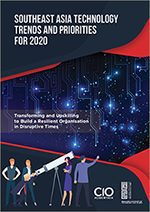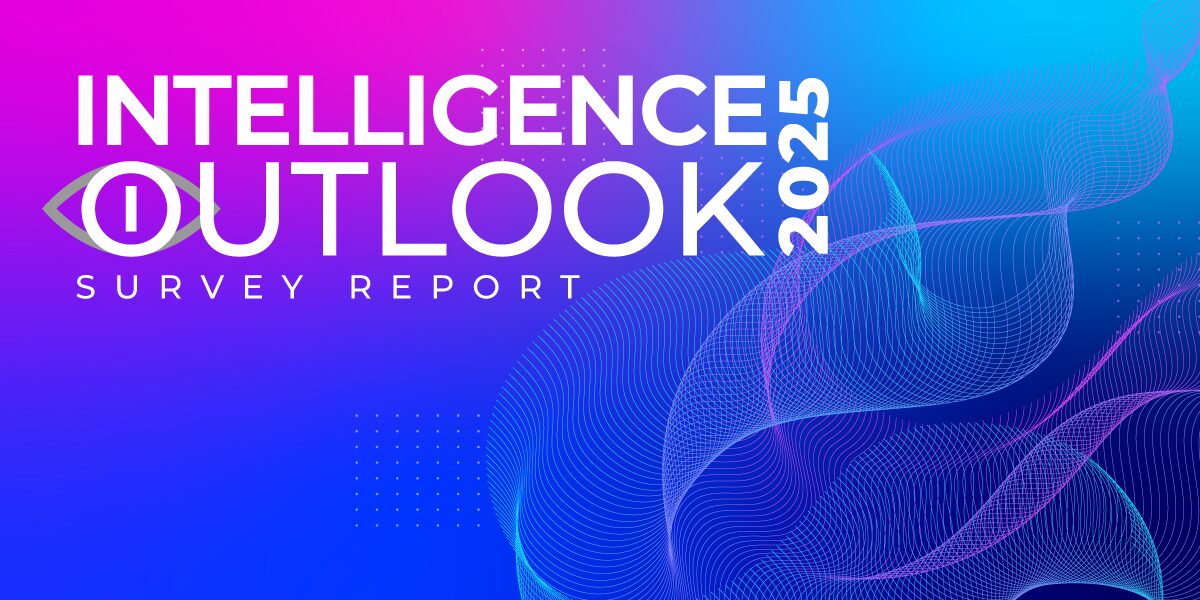CIO Academy Asia #HASHTECH Insights
April 17, 2020
On 7 April, CIO Academy Asia (CIOAA) conducted a virtual roundtable attended by 10 technology industry leaders across several sectors. The discussion was centred on the findings of CIOAA’s Southeast Asia technology trends and priorities 2020 survey. Moderated by CIOAA, the roundtable provided an opportunity to get detailed feedback from the IT community, on its survey and insights.
The discussion covered 5 key pillars addressed by the survey, namely digital transformation, innovation catalysed by emerging tech, digital upskilling to compete effectively, cyber resilience and the impact of COVID-19.
Customer-centricity and data analytics drive digital transformation
The CIOAA survey reveals that ‘evolving customer needs and expectations’ is the largest driver behind Southeast Asian organisations’ digital transformation initiatives and that data analytics is the largest digital transformation technology trend. The discussion focused on these issues and participants went on to highlight access to the right skills and security, as key challenges. The CIOAA survey also reveals that the need for training and upskilling, and evaluating cybersecurity risks, are the most urgent challenges when undergoing digital transformation.
When asked, in the survey, to name the digital transformation trend that will have the biggest impact on business for the next 1-2 years, data analytics was chosen most frequently. This was validated by many of the comments made during the roundtable. For some, data analytics is critical to both top and bottom line growth strategies. It gives visibility of the whole business and allows decision makers to increase operational efficiency and to understand what is driving growth. The discussion then focused on the challenges of obtaining consistent data and of hiring data scientists. There is a huge shortage of data analysis skills and where training is not adequate, companies seek to automate. Participants noted that data analytics tools face some challenges with today’s COVID-19 scenario because panic buying is making it difficult to predict demand and manage supply chains, with even the best data analytics.
COVID-19 crisis turbo-charges secure digital engagement and virtual collaboration
The discussion inevitably shifted to the topic of COVID-19 in the context of the CIOAA survey. Attendees shared their experiences of the remote working model and highlighted some of the challenges including training, network performance and exposure to greater cybersecurity risk. They also discussed how the COVID-19 crisis is causing organisations to innovate, and to re-prioritise and accelerate some digital transformation projects -specifically those that address immediate needs – such as digital engagement projects. This is leading to greater innovation as organisations look for ways of remaining operational and maintaining engagement with customers, employees and suppliers. The CIOAA survey shows that innovation and design is the most important competency for digital leaders. The roundtable discussion reinforced the need for innovative thinking in today’s massively disrupted business environment.
The COVID-19 crisis is driving organisations to be more innovative in how they engage with stakeholders. Given that face-to-face engagement is not possible, organisations are urgently pursuing digital engagement strategies and using data to optimise their supply chains. NTUC is seeing a shift to its digital channels. Previously, it was not perceived as an online retailer because of its strong physical presence all over Singapore. Existing online retailers are currently overwhelmed with demand so people are looking for online alternatives. For NTUC, this digital engagement is helping it to speed up its digital transformation programs.
Prem Pavan, Vice President – Asia at Citrix gave the example of innovation and greater digital engagement that is necessary to remain operational in the education sector. He stated that “We are also seeing institutions being forced to change the way they teach and interact with students. For example, the University of Sydney. With the ongoing travel restrictions stranding more than 14,000 students from University of Sydney in China, the institution turned to technology to continue delivering knowledge and education despite the distances. Working with Citrix, the university connected China-based staff and students to its AWS Cloud in Sydney, providing seamless access to the applications and data needed to continue teaching and learning from the comfort and safety of their residences.”
It was noted that the COVID-19 crisis has led to a huge increase in the adoption of virtual collaboration, and cloud services are being more widely used. The cloud computing model has been successful in offering the adaptability, flexibility and scalability that is required as enormous numbers of people start to work from home simultaneously.
Greater emphasis on employee experience as business continuity plans prove inadequate
Participants in the roundtable discussion also highlighted the inadequacy of today’s BCPs at addressing the COVID-19 crisis. Typically, BCPs focus on physical issues such as high availability and access to alternative sites, if one site becomes unusable. This crisis is radically different to the crises anticipated by BCPs because it is about people and the need to enable them to work from home. People need to be able to operate as productively as possible, with secure access to resources, from home. According to Pavan, “The focus needs to be on employee experience as there is a direct correlation with customer experience.” Pavan also commented, “There is a focus on the present and the existing needs of customers. For example, in food delivery, contactless delivery is not a major task, but it makes a big difference to meeting customer needs, in the present.”
Some participants shared their experiences of remote working so far. Many observed a drop in productivity with some seeing their colleagues suffer from ‘working from home fatigue’ or ‘cabin fever.’ The importance of sharing best practices in remote working and making employees comfortable in the home environments was amplified.
COVID-19 crisis – not all doom and gloom
The discussion moved on to some of the possible ‘silver linings’ that might emerge from the crisis. Organisations who have been slow to adopt digital transformation find themselves on a ‘burning platform’. For example, some organisations have not implemented digital engagement platforms and continue to depend on face-to-face interactions. This crisis is forcing them to evaluate their existing business activities and digitalise engagement where possible, or risk being unable to operate. This also drives innovation within organisations as they seek ways in which physical activities that involve human contact, can be enhanced or transformed with digital alternatives. Remote working also offers flexibility and some efficiencies, such as reducing the costs associated with office spaces. Flexible working practices can be implemented such as engaging working mothers – who may be reluctant to work in an office – to work from home.
Participants view the current crisis as an opportunity to reflect and to re-prioritise both at a personal and professional level. It is also clear that the gap between work and personal life is narrowing and employees must find new ways of ensuring that their work life balance matches their needs.
Overall, the feedback from the IT community showed that, in line with the findings from CIOAA’s survey, cyber resilience, adaptability, upskilling, innovation and customer centricity are critical in the unprecedented COVID-19 crisis that we all face.
Closing thoughts
At the end of the roundtable discussion participants were asked for their final thoughts. The most commonly expressed thoughts were:
- Use the opportunity to reflect and re-prioritise
- The situation is creating an immediate need for empathetic leadership
- Take the opportunity to invest in upskilling
- This is the most disruptive time of our lives and a ‘new normal’ business environment will emerge when the crisis ends
- Ensure cyber hygiene and strive for resilience
- The crisis has led to a focus on people, specifically, the needs of employees
- Keep healthy and stay at home
Virtual Roundtable Participants:
- Sreeram Iyer – Global Chief Operating Officer for Corporate and Institutional Business, ANZ Bank
- Siew Choo Soh – Managing Director, Group Head of Consumer Banking and Big Data/AI Technology, DBS Bank
- Shivani Saini – Global Vice President, Technology, GSK
- Arvind Mathur – Chief Information Officer – AMEA, Kellogg Company
- Steve Ng – Vice President, Digital Platform Operations, MediaCorp
- Ramesh Munamarty – Group Chief Information Officer, NTUC Enterprise
- Linus Tham – Group Chief Information Officer, IHH Healthcare
- David Malligan – Director Delivery Enablement Asia, Prudential Assurance Company Singapore
- Vicky Abhishek – Chief Technology Officer – Bottling Investment Group & Asia Pacific Group, The Coca-Cola Company
- Prem Pavan – Vice President – Asia, Citrix
- Moderated by: P. Ramakrishna, CEO, CIO Academy Asia
Related post:
‘Empower your employees to work from home’
 The Southeast Asia Technology Trends & Priorities for 2020 Report, published by CIO Academy Asia in collaboration with the Lee Kuan Yew Centre for Innovative Cities at SUTD, is now available for download.
The Southeast Asia Technology Trends & Priorities for 2020 Report, published by CIO Academy Asia in collaboration with the Lee Kuan Yew Centre for Innovative Cities at SUTD, is now available for download.
Visit here to get your copy








